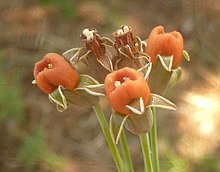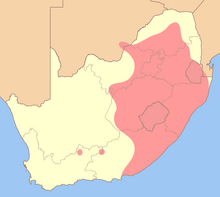Tulbaghia acutiloba
| Tulbaghia acutiloba | |
|---|---|

| |
| Scientific classification | |
| Kingdom: | Plantae |
| Clade: | Tracheophytes |
| Clade: | Angiosperms |
| Clade: | Monocots |
| Order: | Asparagales |
| Family: | Amaryllidaceae |
| Subfamily: | Allioideae |
| Genus: | Tulbaghia |
| Species: | T. acutiloba
|
| Binomial name | |
| Tulbaghia acutiloba | |

| |
| Distribution of T. acutiloba in South Africa | |
| Synonyms[1] | |
|
Omentaria acutiloba Kuntze (Harv.) | |
Tulbaghia acutiloba, the wild garlic, is a species of plant in the family Amaryllidaceae. First described by William Henry Harvey in 1854, it is found in the countries of Botswana, Eswatini, Lesotho, and South Africa.
Description
[edit]Tulbaghia acutiloba is one of 22 members of the genus Tulbaghia found in tropical and southern Africa.[2] The plant is a small, clump-forming, bulbous perennial that ranges from 15–45 centimetres (5.9–17.7 in) in height.[3][2] The leaves are narrow and grass-like, they are 50–450 millimetres (2.0–17.7 in) in length, and 3–8 millimetres (0.12–0.31 in) in width.[2] The rhizome of the plant can grow to 3 centimetres (1.2 in) in diameter.[3] When the plant is touched, a garlicky scent is emanated.[2]
The flowers are small, trumpet-shaped, around 8 by 4 millimetres (0.31 in × 0.16 in) in size, and green, white, and orange-brown in colour.[3][2] Khaki colored flowers are surrounded by green, recurved tepals, and a fleshy orange to reddish-brown ring, with an umbel of around 2 to 6 flowers.[2] The flowers are sweet in scent, and the scent is particularly noticeable during the evening. The plant flowers throughout the year, mainly between the months of August to November, which is late winter to early summer in Southern Africa.[2] The plant can flower multiple times in a single season.[2]
Range
[edit]
Tulbaghia acutiloba is found in the countries of Botswana, Eswatini, Lesotho, and the eastern portions of South Africa.[3] In South Africa, it is found in the provinces of Eastern Cape, Free State, Gauteng, KwaZulu-Natal, Limpopo, Mpumalanga, and North West.[2] In Botswana, it is found in the southeastern portion of the country.[4]
Habitat
[edit]The preferred habitat of Tulbaghia acutiloba is dry, rocky, grasslands of an elevation up to 1,800 metres (5,900 ft).[2]
Human interactions
[edit]The leaves of the plant are edible,[2] and young plants are eaten as food.[5] In the provinces of Eastern Cape and KwaZulu-Natal, it is used as a culinary herb.[6] Traditionally, T. acutiloba was used to treat various illnesses, including infectious diseases and hypertension.[6]
Conservation
[edit]In an assessment of South African plants in 2009 by Raimondo et al., Tulbaghia acutiloba was ranked as "Least Concern".[7]
Etymology
[edit]The generic epiphet Tulbaghia is derived from Ryk Tulbagh, the governor of the Cape of Good Hope.[3] Tulbagh's extensive correspondences with Carl Linnaeus included sending him 200 plant specimens, among which was a specimen of Tulbaghia acutiloba sent in 1769 which led to its description.[2] The specific epiphet acutilobus denotes the plant's "sharply pointed lobes",[3] from the Latin acutus "acute, pointed" and lobus "lobe",[8] which likely refers to the flower's tepals.[2]
It is commonly known as "Wild Garlic" in the English language.[3][2][9] It is also known locally as "Wildeknoffel" in Afrikaans, "isihihi" in the Xhosa language, "ishaladi lezinyoka" in the Zulu language, and "motsuntsunyane" or "sefothafotha" in the Southern Sotho language.[2][7][5]
Taxonomy
[edit]Tulbaghia acutiloba was first described in 1854 by William Henry Harvey.[3] Formerly placed in the family Alliaceae, the family was merged into the larger family Amaryllidaceae as per the APG IV system in 2016.[3]
References
[edit]- ^ "Tulbaghia acutiloba". Mindat. Hudson Institute of Mineralogy. Retrieved 1 July 2024.
- ^ a b c d e f g h i j k l m n o Ndlovu, Bathabile; Notten, Alice (February 2019). "Tulbaghia acutiloba". PlantZAfrica. South African National Biodiversity Institute. Retrieved 1 July 2024.
- ^ a b c d e f g h i "CAUDICIFORM Tulbaghia acutiloba". Bihrmann's CAUDICIFORMS. Retrieved 1 July 2024.
- ^ Hyde, M.A.; Wursten, B.T.; Ballings, P.; Coates Palgrave, M. "Species information: Tulbaghia acutiloba". Flora of Botswana. Retrieved 1 July 2024.
- ^ a b "Tulbaghia acutiloba". Biodiversity Explorer. Iziko South African Museum. Retrieved 2 July 2024.
- ^ a b Arhin, Isaiah; Moodley, Kogi; Baijnath, Himansu; Ibrahim, Usri H.; Mackraj, Irene (September 2023). "The Antihypertensive Effect of Hydro-methanolic Extract of Tulbaghia acutiloba Harv. in L-NAME induced Hypertensive Rats". Clinical Complementary Medicine and Pharmacology. 3 (3): 100101. doi:10.1016/j.ccmp.2023.100101. Retrieved 2 July 2024.
- ^ a b Archer, R.H.; Victor, J.E. (2005). "Tulbaghia acutiloba Harv. National Assessment". Red List of South African Plants. South African National Biodiversity Institute. Retrieved 1 July 2024.
- ^ Condy, G. "Tulbaghia acutiloba Harvey". Plant Illustrations. Retrieved 3 July 2024.
- ^ Charters, Michael L. "Tulbaghia acutiloba Harv". Flora of Southern Africa. California Plant Names: Latin and Greek Meanings and Derivations and Wildflowers and Other Plants of Southern California. Retrieved 1 July 2024.